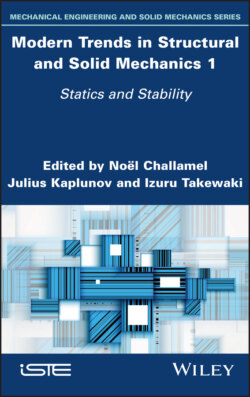Читать книгу Modern Trends in Structural and Solid Mechanics 1 - Группа авторов - Страница 17
1.3. Results and discussion 1.3.1. Verification of the numerical algorithm
ОглавлениеTo verify the algorithm and to establish the accuracy of computed results, we study the problem analytically analyzed by Pagano (1969). It involves a four-layered [0/90/90/0] simply supported square laminate of side length a, with the sinusoidal surface traction
[1.12]
applied only on the top surface. The material of the layers has the following values of the moduli:
[1.13]
Here, E, G and ν denote Young’s modulus, shear modulus and Poisson’s ratio, respectively, and subscripts L and T indicate directions parallel and transverse to the fiber direction. Following Pagano, we express the results in terms of the non-dimensionalized quantities defined in equation [1.4] and employ (x, y, z) = (x1, x2, x3) as the coordinate axes and (u, v, w) = (u1, u2, u3)
[1.14]
In Table 1.1, we compare our results of select quantities with those in Pagano (1969) for the plate aspect ratio a/h = 100, 10, 4 and 2. It is clear that the developed least-squares method algorithm yields highly accurate results for the simply supported laminate.
Table 1.1. Comparison of the results with the 3D exact solution of Pagano for the [0/90/90/0] laminate
| a/h | - | ||||||
|---|---|---|---|---|---|---|---|
| 2 | Pagano | 1.38841-0.91165 | 0.83508-0.79465 | -0.086300.06732 | 0.15300 | 0.29458 | 5.0745 |
| Present | 1.38020 -0.90607 | 0.83038-0.79049 | -0.085990.06711 | 0.15311 | 0.29428 | 5.0643 | |
| 4 | Pagano | 0.72026-0.68434 | 0.66255 -0.66551 | -0.046660.04581 | 0.21933 | 0.29152 | 1.93672 |
| Present | 0.72020-0.68427 | 0.66246-0.66541 | -0.046650.04575 | 0.21939 | 0.29154 | 1.93660 | |
| 10 | Pagano | 0.55861-0.55909 | 0.40095-0.40257 | -0.027500.02764 | 0.30137 | 0.19595 | 0.73698 |
| Present | 0.55862-0.55910 | 0.40096-0.40257 | -0.027470.02761 | 0.30140 | 0.19597 | 0.73698 | |
| 100 | Pagano | 0.53885-0.53887 | 0.27101-0.27103 | -0.021350.02136 | 0.33880 | 0.13894 | 0.43460 |
| Present | 0.53883-0.53885 | 0.27100-0.27102 | 0.021353-0.021355 | 0.33880 | 0.13894 | 0.43460 |
For a/h = 100, the maximum error in the computed quantities equals 0.023% for the in-plane shear stress at point (0, 0, −h/2), and for a/h = 2, the maximum error is 0.612% for the in-plane axial stress at point (a/2, a/2, −h/2). The errors for a/h = 10 and 4 are between those for a/h = 100 and 2. The through-the-thickness plots of , , , and coincide well with those from Pagano’s solution and are omitted.
For a/h = 10 and 2, we conducted the following five numerical experiments, E1, E2, …, E5, by varying N1, N2 and N3. In E1 and E2, N3 was set equal to either 3 or 4 and N1 = N2 was assigned values 4, 6 and 8; in E3 and E4, N1 = N2 = 4 and N3 was given values 3, 4, 6 and 8; and in E5, N1 = N2 = N3 were assigned values 4, 6 and 8. Thus, a total of 13 combinations of N1, N2 and N3 were evaluated for each value of a/h, and values of u, v, w, σxx, σyy, σxy and σxz at typical points were compared with their analytical values. For a/h = 10, N1 = N2 = 8, N3 = 3 (total degrees of freedom (DOFs) = 9,477) provided an error of less than 0.1% in the value of each of these seven variables. Keeping N1 = N2 = 8 and increasing N3 = 4, 5 marginally decreased the error, suggesting that there is no benefit derived from the increased computation cost. For a/h = 4, all 13 combinations of values of N1, N2 and N3 resulted in an error of 7.25% in w and the error in σxz decreased from 37.7% for N1=N2=N3 = 4 to 0.03% for N1 = N2 = N3 = 8 (DOFs = 24,057).
